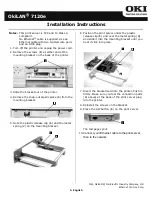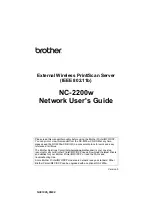
Page 17/21
UTEK TECHNOLOGY (ASIA) CO., Ltd.
http://www.szutek.com
0755-27886063
2. Make sure that the network adapter is available and can communicate with other local hosts.
3. Turn off any tools or software that would shield broadcast packets (don’t run the system integrated firewall)
4. If after an abnormal disconnection such as power down during IP configuration through a browser, no device can be
found, reconfigure IP through the console.
b)
Unable to open a serial port
1. Make sure the network status is normal and the server can be pinged through.
2. Check operation status to find out if the port is occupied.
3. If the port is occupied, find out if the settings in “COM PORT OVER TCP/IP” are correct through realport.
4. Delete the corresponding COM port in the registry and remap.
c)
Can’t receive/send data
1. Make sure that the serial port can be opened normally
2. Find out if the “TX” value in [System Stats]
Æ
[ Network Interface Information] is increased. If not, check the connection
between the serail port and the upper end network; if TX is increased but the bottom serial port device dosen’t receive,
check the cable.
3. Find out if the “RX” value in [System Stats]
Æ
[ Network Interface Information] is increased. If not, check the connection
cable; if yes, check the connection between the serail port and the upper end network.
d)
Forget the password previously set
1. Press the “reset” button and hold for 3 s and then release, the password will be eliminated temporarily. However, the
password will be recovered up on the reboot after power down.
e)
Lousy code received/sent
1. Make sure the cable connection is correct. Specially, problem of parallel cables should be noticed for our 485 devices.
2. Check if the cable length exceeds the standard distance and the cable quality (increasing the transceiver or the
optical shutter is also applicable)
3. Make sure the baudrate set matches with the bottom end device
4. Find out if it is possible to receive normal data using network or serial port commissioning assistant without upper end
software. If can, the problem might be something with the packing mechanism, set the length and waiting time for the
packing in ” Serial Port Communication Settings”
Æ
” Advanced Setting”.
f)
The serial communication server is used as the dialing server and the connection is established
normally. But it can’t be open by a PC using IE, while inputting the IP in the address bar will do
1. Whether or not the [Allocate DNS server] in [Specific parameters] of [PPP daemon] of the serial communication server
is “Yes”, and the DNS set in [Server] is valid.
g)
The serial communication server is used as a dialing server and the connection is established normally.
But it can’t be open fully or at all when using IE for complicated pages or downloading of large files
1. Check [Serial ports] in the serial communication settings to make sure that [Flow control] is consistent with the flow
control of the MODEM. Typically, the flow control of the MODEM is achieved through rts/cts (hardware flow control)
2. The DCE rate for negotiation between MODEMs is too low, redial.
h)
Unsuccessful PPP connection
1. Enter into the serial communication server configuration, open [Serial ports] in [Statistics] and find out if the DCD status
is ‘1’ (i.e. if the serial DCD signal of the serial communication server is ‘high’). If not, the serial communication server will
not start PPP
2. Make sure the authentication modes of the client end and the server end are consistent, and the user name and the
password established are matched.





































